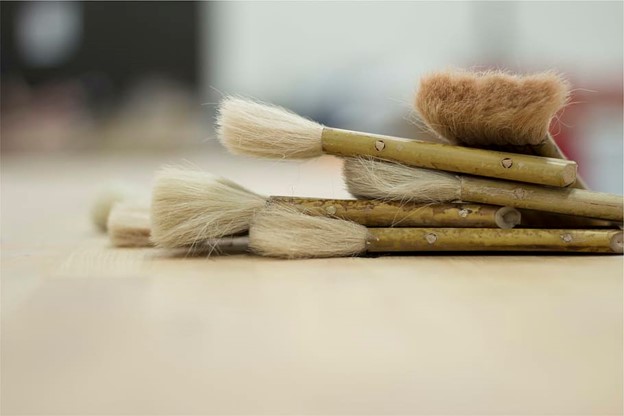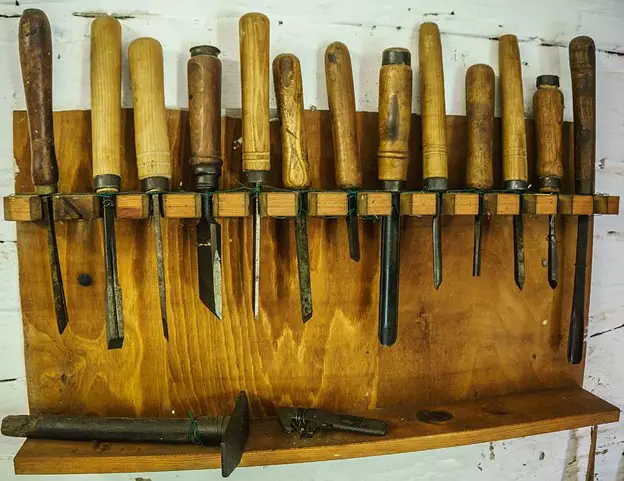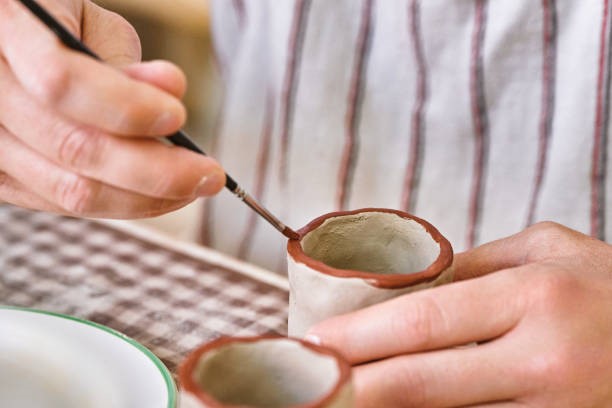The Japanese culture always surprises us. Whether it is the diversity of the place or the artistic practices, everything is so beautiful and versatile about the people and the place. Even in the world of pottery, there is so much to learn from Japanese artists. If you are wondering how good their pottery tools are, this blog is just what you are looking for. Let us take a quick look at the Japanese pottery tools and the right way to use them.
Japanese Pottery Tools: A Quick Insight
Most of the pottery tools that are used to prepare pottery work in Japan tend to be fairly similar to that of the tools used around the world. However, there are certain tools that look particularly peculiar and might help solve a lot of pottery issues.

These special tools include variants such as the Tonbo. This is an amazing tool that serves as an effective yet simple solution. It enables the artists to throw several pots while ensuring the same width and depth. It is prepared from 3 sticks that are arranged in an insect-like shape that has the very same name. Tonbo in English refers to the Dragonfly insect.
How to use Tonbo?
The Tonbo features a vertical tail or stick that helps gauge the overall depth of the pottery piece. On the other hand, the horizontal stick or wing gauges the width of the artwork. Obviously, you would require different stick lengths for ceramic artworks of varying sizes. However, there is an insert section in the wing area that can help you adjust the length of the stick to accommodate pottery pieces of varying sizes.
Doing this helps erase the requirement for a new tonbo. In the US, potters gauge the height & width of the pottery piece by using two pointer sticks. This can be done by either sticking 2 thin wire pieces into the clay and around the wheel rim.
Apart from this, Hakeme is a commonly used Japanese pottery tool. For example, Hakeme or Brush is used for the pottery slip technique. It was also used along with some versatile painted decorations back in the 1536 and 1598 eras. At this time, there was a huge influence in the pottery techniques from the Korean techniques.
Here are some of the popular pottery tools used by Japanese potters, along with their usage.
Japanese Tools |
Usage |
| Hakeme | Brush |
| Etsukefude | Picture Painting Brush |
| Hari | Pin To Create Designs and Holes |
| Kakibera | Loop Tool |
| Kensaki | Pointed Tool for Creating Holes |
| Inhana | Stamp Creating Tool |
| Kanna | Pottery Turning Tool |
| Kiriito | Potter’s Wire |
| Kigote | Wooden Rib for Pottery Throwing |
| Magarikensaki | Bent and Pointed Tool |
| Pasu | Caliper Pairs |
| Nameshigawa | Chamois Leather |
| Ponsu | Tool for Boring the Clay |
| Supoito | Slip Trailer Tool |
| Terokoro | Banding Wheel |
| Shippiki | Potter’s Wire |
| Takebera | Tool for Bamboo Turning |
| Tonbo | Dragonfly Gauge for Measuring Depth and Width of Pottery |
| Yumi | Bow Cutter Tool |
| Tsugebera | Pottery Modeling Tool |
Lesser-Known Japanese Pottery Tools
Generally, pottery tools in Japan are fashioned from the fast-growing wood variants or bamboo plants. These tools bring in a natural feel to the crafting process, which is very appealing for the buyers. While most of the Japanese artists are familiar with western-standard tools, the Japanese pottery inventions are unique.
Some unique tools used in the pottery escapade by Japanese artists are:
Take BonBon:
Now, the Take BonBon isn’t necessarily a tool for pottery throwing purposes. It is a slip trailer used by Japanese potters. It is a bamboo bottle with high capacity that features a spout for pouring the glaze or slip in a steady manner. It helps pour out a controlled stream of glaze/slip for the potter to draw easily with.
The Xiem Precision applicator is a tool similar to that of BonBon. Its lightweight design makes it easy for the potters to use it for long without straining their hands.
Gyubera:
Also known as Cow’s Tongue, Gyubera is a long sledge-type bamboo rib set that is used for compressing the bottoms & shaping up the sides of a straight-sided bowl. These are traditional tools that belong from the Lenguas de vaca, Arita Kyushu, Piezas de Madera, and so on.
Marugote:
The Marugote is a shallow and round clamshell-like bamboo rib that is used for shaping up the curved bowl sides. They can be used for compressing the bottom area of the thrown forms.
Dango:
A Dango is similar to wooden ribs, and these bamboo ribs are shaped like leaves. They can be used for shaping up & smoothening out the pottery surface.
Yumi:
The Yumi features a wire & harp made of bamboo trimming that doubles up as a unique fluting tool. Yumi can also be used for cutting off torn or uneven rims & also for faceting of the leather-hard clay forms.
Takebera:
Takebera is a bamboo trimming & modeling knife that is available in different shapes used for the purpose of carving, cutting, cleaning up the wet clay pots, or for the purpose of sgraffito.
Tsurunokubi:
Tsurunokubi has a crane-like neck with an s-curve that is prominently used in Japanese pottery making. These throwing sticks are ideal for shaping up the interior section of the narrow-necked pieces like bottles or certain vases.
Tsuchikaki:
Tsuchikaki is a large ribbon tool in a looped form that is created with the help of iron. It is used for the purpose of trimming & carving.
Kanna:
It is a Japanese tool used for the purpose of carving, cutting, or incision purpose. It is created with the help of iron and can be used for trimming pieces such as sgraffito, carving, or for scraping off any excess glaze.
Kushi:
Kushi isn’t strictly a tool used for throwing purposes. These comb-shaped tools are used for scoring at least 2 decorative lines that are parallel to each other on the surface of the pottery work. In the Japanese pottery domain, the Kushi can have around 20 teeth.
Umakaki:
The Umakaki is a harp used for trimming purposes. It is used for leveling the flat and wide surfaces like the bottom portion of any shallow plate or dish.
If you are looking forward to getting your hands on such creative pottery tools from Japan, you can try out an Inhana brought to you by MKM Pottery. The Twig Roller-Sea of Japan is a unique wooden pottery tool that can be used to design clay pieces in 27 varying patterns.
Learning More About the Japanese Pottery Work
Japan has an abundance of wood which is why you can find it being used in a lot of daily used objects that include pottery tools as well. Imperfections are celebrated in Japan, given that it makes the artwork unique. Plus, handmade pottery used to feature ridges left due to the fingers making it unique and one of a kind for the buyers. Even the accidental marks made by the Japanese tools were left untouched due to the beauty they added.
Hand modeling in Japan was practiced even after the use of pottery wheel had started for a long. The irregularities and asymmetries were sought purposely. Similar effects were also sought after in the glazing process. Potters are used to letting the colored glazes run through and create marvelous streaks with the irregular application.
The glazes were also thick and covered with several bubbles while showing a treacly or semifluid appearance. Deeply fissured and crackled glazes were induced deliberately. These happy mistakes were also termed lizard skin or dragon skin. Painted decorations that frequently included brown, blue, and red colors could be seen prevalently in Japanese pottery.
Importance of Bamboo in Japanese Pottery Work
Pottery tools made by bamboo have been predominant in the East Asian area for centuries. It is a top choice of material for pottery enthusiasts for several reasons. Let us take a look at some of the prominent benefits of using bamboo pottery tools:
-
Bamboo is Aesthetically Pleasing:
Most potters get into the art of pottery making as they want to get close to nature. Clay is the closest you can get to nature. However, the use of synthetically manufactured tools might pollute the essence of being a part of nature. So, for the folks that love to be one with nature, bamboo pottery tools are no doubt an aesthetically pleasing option.
-
Bamboo is very Durable:
Bamboo isn’t a tree, rather a long-running grass that features a durable, lightweight, and flexible grain material. With the help of a sharp tool, bamboo can easily be shaped into a design of your choice. Moreover, this material holds an edge over other types of wood. It is far more durable and can be used heavily in the long term.
Unlike metallic instruments used with pottery work, tools made up of bamboo material do not wear you out even if used for a long time. Moreover, its lightweight design gives it the flexibility to be moved around throughout the pottery work with ease without hindering the movement.
-
Low-Maintenance Material:
As compared to wood, bamboo pottery tools do not require additional soaking in any oil to keep it resistant to water. It has far superior durability as compared to that of wood. Even with constant exposure to water and clay, which happens during pottery making, the bamboo tools do not become soft, cracked, waterlogged, or even warped.
Bamboo-based pottery tools can withstand constant exposure to water for an extended time period. Essentially, it won’t rust like your metallic pottery tools or rot like any wooden ones. This makes bamboo an ideal choice for pottery work.
-
Fits Easily into the Contours of Your Hand:
Another factor that makes bamboo an amazing choice for Japanese pottery tools is the fact that it fits right into the contour of human hands in a remarkable way. The ease of use paired with toughness, lightweight, and aesthetic look makes this wood an ideal choice for throwing purposes.
-
Environment-Friendly Choice:
Bamboo is one of the fastest-growing trees in the world. Or rather the fastest growing grass. This means, unlike other trees that cannot be re-harvested, bamboo can be re-harvested for several years. Bamboo features an intricate root system. This helps the grass to regenerate year after year post-harvesting. Bamboo wood can be harvested every three to five years, depending on the bamboo species.
Bamboo tends to grow in a large amount and can be harvested selectively on an annual basis while keeping the greens intact in the area. It is the best way to reduce any possible carbon footprint that can happen during the manufacturing process of artificial pottery tools.
Conclusion
That being said, the Japanese potters sure know how to make the best use of nature and craft the most intricate pottery work using some unique tools. Whether it is the potter’s rib or the trimming loops, Japan has its own version of all the important pottery tools. So, if you plan on keeping it environment-friendly or looking for something that feels true to nature, Japanese pottery tools are no doubt a great choice for beginners as well as expert crafters.








